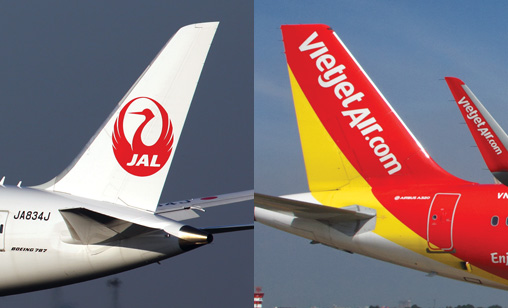Addendum
Japan Airlines-Vietjet code share disappoints analysts
September 1st 2017
In an eyebrow raising development in late July, youthful low-cost carrier, VietJet Airlines, and venerable veteran, full service carrier, Japan Airlines (JAL) announced their intention to form a code share union. Read More »
On a superficial level, it appeared an uncomfortable matching, but to industry observers it was hardly surprising. Pushing the odd couple carriers into the relationship was the simple fact that Vietnam’s flag carrier, Vietnam Airlines, and All Nippon Airways (ANA) had formed their own code share last October after ANA invested 8.8% (US$106 million) in the state-owned airline.
 |
The ANA investment abruptly ended a code share between JAL and Vietnam Airlines that had been in place since April 1996.
Until March this year, JAL was not allowed to expand. The limitation was one of the conditions imposed on the carrier when it was given government backed assistance to progress through its bankruptcy rehabilitation.
The 8:12 Paper, drafted by the Ministry of Transport, applied for five years from August 2012. A director of Japan Aviation Management Research, Haruo Ushiba, said the JAL/VietJet code share agreement was a replacement for the previous JAL/Vietnam Airlines code share.
“By itself, the JAL/VietJet partnership is not impressive at all to those who expected a more dynamic, global expansion strategy from JAL now that the 8:12 ban is lifted. It’s really disappointing,” said Ushiba.
Partnerships between LCCs and full service carriers such as code shares are not unusual these days, Ushiba said. He cited precedents set by Ryanair and Air Europe and Emirates and flydubai.
“There are many cases where major legacy carriers have internal LCCs, for example, Lufthansa and Eurowings. IAG has Level and Air France is launching Joon,” said Ushiba, who added JAL is one of many full service airlines which has a tie-up with JetBlue in the U.S.
Benefits for VietJet and JAL will include code-sharing and the transfer of frequent flyer miles earned on one airline to the other. The arrangement will apply on all routes between Vietnam and Japan and to the domestic routes of both carriers. VietJet plans to launch scheduled services to Japan in 2018.
In the future, there could be international network gains beyond Japan for VietJet and the opportunity to benefit from JAL’s international know-how. For JAL, VietJet could be a springboard beyond Vietnam to Southeast Asia. JAL operates daily non-stop flights between Tokyo/Narita and Ho Chi Minh City and Hanoi respectively, in addition to Tokyo/Haneda - Ho Chi Minh.
Vietjet started flying in December 2011 and built its domestic market share to 41.5% in 2016, which was just below Vietnam Airlines’ 42.5%. The Vietnamese LCC plans to its double its international revenue by launching several regional destinations in the next 18 months. It has a fleet of 45 aircraft, operates 350 flights a day to 73 domestic and regional destinations in Cambodia, China, Hong Kong, Malaysia, Myanmar, Singapore, South Korea, Taiwan and Thailand.